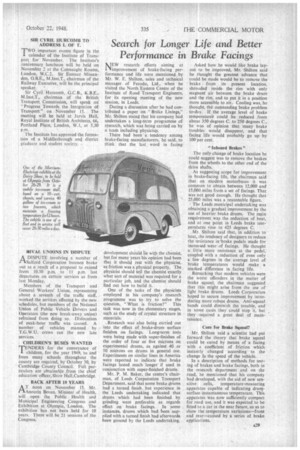Search for Longer Life and Better Performance in Brake Facings
Page 31

If you've noticed an error in this article please click here to report it so we can fix it.
NEW research efforts aiming at improvement of brake-facing performance and life were mentioned by Mr. W. E. Shilton, sales and technical manager of Ferodo, Ltd., when he visited the North Eastern Centre of the Institute of Road Transport Engineers, for its opening meeting of the new session, in Leeds.
During a discussion after he had contributed a paper on "Brake Linings," Mr. Shilton stated that his company had undertaken a long-term programme of research, which was being carried on by a team including physicists.
There had been a tendency among brake-facing manufacturers, he said, to think that the last word in facing
development should fie with the chemist, but for many years his opinion had been that it should rest with the physicist, as friction was a physical property. The physicist should tell the chemist exactly what sort of material was required for a particular job, and the chemist should find out how to build it.
One of the tasks of the physicists employed in his company's research programme was to try to solve the question, "What is friction?" This task was now in the elementary stages, such as the study of crystal structure in materials: . Research was also being carried out into the effect of brake-drum surface finishes on facings. Long-term tests were being made with super-finishes of the order of four or five microns on experimental drums, as against 40 or 50 microns on drums in general use. Experiments on similar lines in America were reported to indicate that brake facings lasted much longer if used in conjunction with super-finished drums.
Mr_ P. M. Baker, the centre's chairman. of Leeds Corporation Transport Department, said that some brake drums had a turned finish, but experience in the Leeds undertaking indicated that drums which had been finished by grinding were preferable as regards effect on brake facings. In some instances, drums which had been supplied with a turned finish had afterwards been ground by the Leeds undertaking. Asked how he would like brake layout to be improved, Mr. Shilton said he thought the greatest advance that could be made would be to remove the brake • from its present location, shrouded inside the rim with only stagnant air between the brake drum and the rim, and to put it in a position more accessible to air.. Cooling was, he thought, the outstanding brake problem to-day. If the average level of brake temperatures could be reduced from about 350 degrees C. to 250 degrees C., he was of opinion that many brake troubles would disappear, and that facing life would probably go up by 100 per cent.
"Inboard Brakes" The only change of brake location he could suggest was to remove the brakes from the wheels to the other end of the drive shafts.
As suggesting scope for improvement in brake-facing life, the chairman said that on modern motorbuses it was common to obtain between 12,000 and 15,000 miles from a set of facings. That was not good enough. He thought that 25,000 miles was a reasonable figure. The Leeds municipal undertaking was obtaining a gradual, improvement by the use of heavier brake drums. The main requirement was the reduction of heat, and at one point in Leeds brake temperatures rose to 425 degrees C.
Mr. Shilton said that, in addition to heat, the tendency of designers to reduce the resistance in•brake pedals made for increased wear of facings. He thought a little more resistance at the pedal, coupled with a reduction of even only a few degrees in the average level of brake temperatures would make a marked difference in facing life.
Remarking that modern vehicles were the worst offenders in the matter of brake squeal, the chairman suggested that this might arise from the use of light brake drums. Leeds Corporation hoped to secure improvement by introducing more robust drums. Anti-squeal bands could diminish the trouble, and in some cases they could stop it, but they required a great deal of maintenance.
Cure for Brake Squeal?
Mr. Shilton said a scientist had put forward the theory that brake squeal could be cured by means of a facing with a coefficient of friction which instantly changed according to the change in the speed of the vehicle.
In a description of methods for testing of brakes and brake facings, both in the research department and on the road, he mentioned that his company had developed, with the aid of new sensitive cells, temperature-measuring apparatus capable of indicating drumsurface instantaneous temperature. This apparatus was now sufficiently compact for road use, and it was expected to be fitted to a car in the near future, so as to show the temperature variations—front and rear—caused by a series of brake applications.




















































































